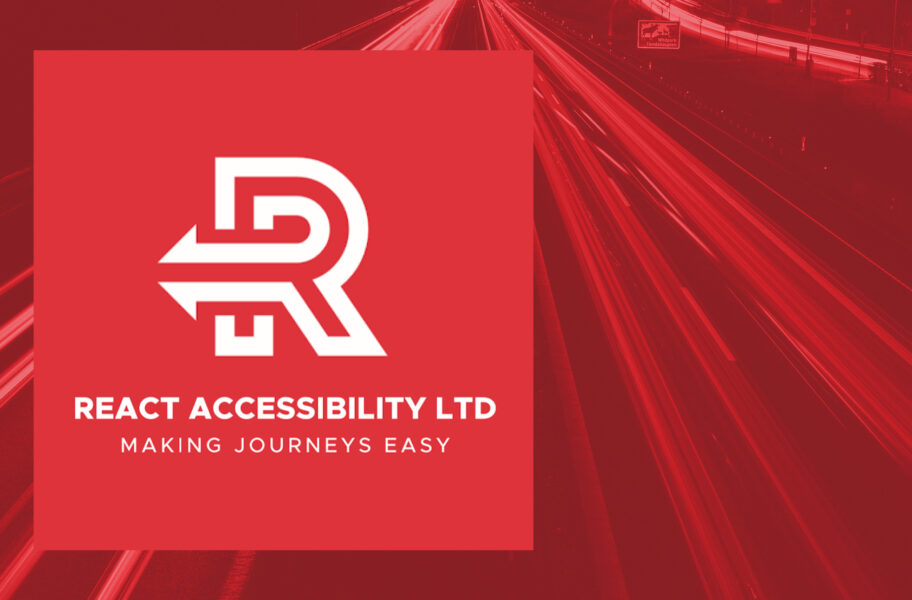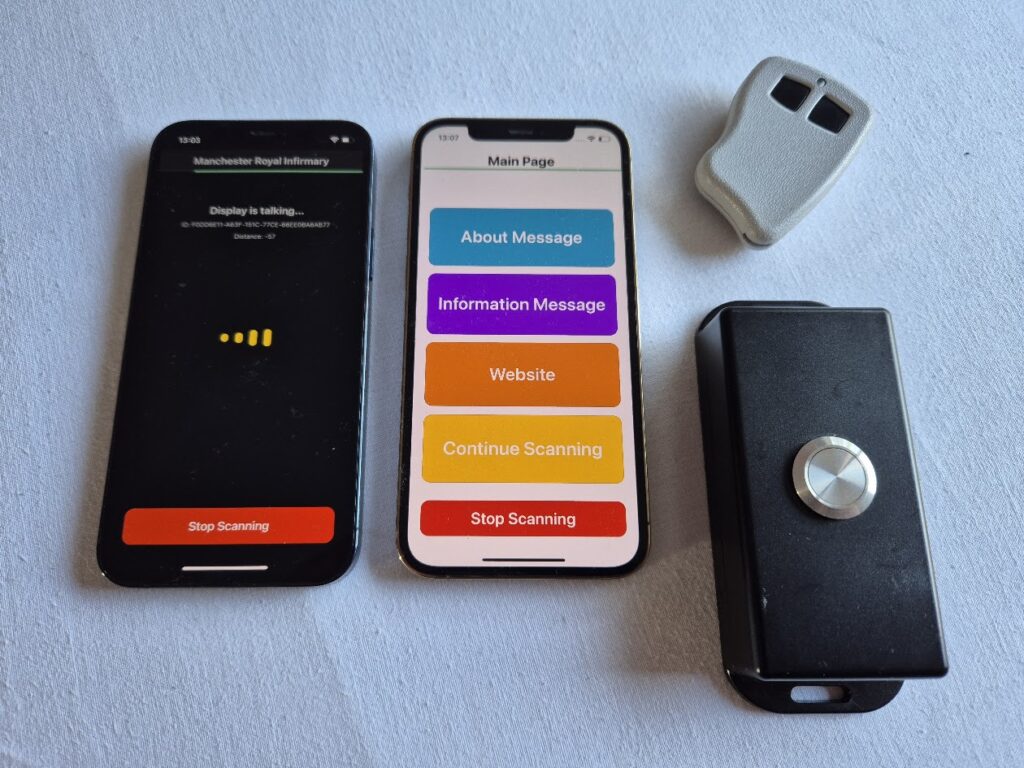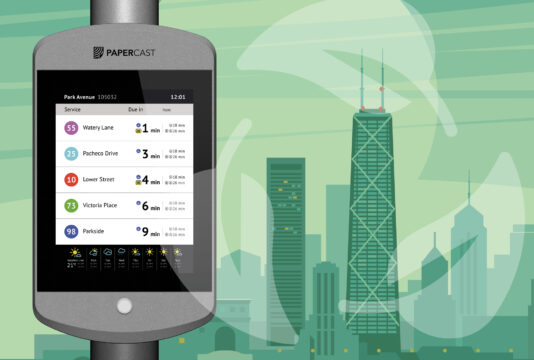
Meet the Papercast CMS Layout Catalogue: A must have resource for sharing visually impactful passenger information
We’re excited to tell you about the Papercast Content Management System (CMS) Layout Catalogue, an…

We’re excited to share that Papercast has partnered with REACT Accessibility Ltd to bring their REACT Trigger System to our e-paper digital bus stop displays.
This is an enhancement to Papercast’s leading accessibility features, designed to make real-time travel information even more accessible and user-friendly for everyone, especially those who rely on audio cues to navigate public transport.
Travel should be simple and stress-free, but for many people, accessibility barriers make it more complicated than it should be. In the UK, disabled individuals take 38% fewer trips than those without disabilities. This is due to a range of factors including physical accessibility challenges and service limitations, but also often because information isn’t easy to access. That’s where this partnership comes in.
By integrating REACT’s smart, flexible technology into our low-power bus stop displays, we’re helping close that gap – helping to make public transport more inclusive.
The REACT Trigger System turns digital displays into ‘talking displays,’ providing audio announcements with real-time travel updates. It offers three simple ways for passengers to activate audio announcements.

The free app automatically activates display audio announcements when users approach, offering a hands-free and hassle-free experience. Users can customise settings for frequency, language, contrast and more. Additionally, the app serves as an accessible gateway, providing secure, direct access to approved websites based on the trigger location, such as a travel journey planner website.
Video Description: A Papercast display is shown on a white background next to a smartphone. A person uses the phones voice control to open the REACT app, which launches straight into the App scanning mode, detects the Papercast displays presence, with phone announcing the bus stop location. The display then speaks its visually presented information, announcing the upcoming bus departures from the stop.
The fob automatically activates display audio announcements when users approach, again, hands-free and hassle-free. Further audio is triggered through simple button presses.
Video Description: A Papercast display is shown on a white background, and a person’s hand is shown turning a personal fob on by presses its two buttons together. The display automatically announces its location alerting the person to the display’s presence at the bus stop. The person then presses the left fob button and the display announces further wayfinding information. The person then presses the right fob button and the display announces the upcoming bus departures from the stop.
A fixed button at bus stops for those who can access a simple press-to-hear option.
Video Description: A Papercast display is shown on a white background, and a communal pushbutton is added by a person’s hand. The person then presses the pushbutton, triggering the display to speaks its visually presented information, announcing the upcoming bus departures from the stop.
We’re the first to integrate REACT into off-grid, solar-powered e-paper displays, meaning we can offer more accessible, real-time information even in remote areas where mains power isn’t available. It’s a practical, efficient solution for transport operators looking to improve accessibility without overhauling their entire infrastructure.
_________________________________

To get more insights into this collaboration, we caught up with Keith Willis, Operations and Commercial Director of REACT, to talk about accessibility, innovation and the impact of making transport information truly inclusive.
Keith leads efforts to develop and implement innovative accessibility solutions for public transport. With extensive experience in the transport technology sector, Keith has been instrumental in driving the adoption of the REACT Trigger System. His background includes leadership roles in transport information technology, focusing on enhancing mobility and independent travel through accessible information systems.
Q: Can you tell us a bit about REACT?
REACT was founded in 2018 and is based in the UK. We specialise in assistive technology designed to make public transport more inclusive, with a particular focus on providing accessible information for all passengers. Our flagship product, the REACT Trigger System, has been widely adopted across the UK, enhancing accessibility at numerous transport hubs and bus stops.
Q: What inspired the development of the REACT Trigger System, and how has it evolved to meet the needs of today’s passengers?
We saw a clear gap in how public transport information was being shared – it wasn’t reaching everyone equally, especially people with visual impairments. The goal was simple: make digital displays talk. Over time, we added different ways to trigger the audio – app, fob, push button – because people have different preferences and needs. It’s all about giving passengers options and independence.
Q: Why is accessibility in public transport so important, and how does technology help close the gap?
Getting around should be easy for everyone. Public transport connects people to jobs, schools, healthcare and social activities. When information isn’t accessible, it creates unnecessary stress and barriers. Technology like REACT helps break those barriers by making real-time information available in a way that works for different people. It’s about levelling the playing field.
Q: Papercast is the first to integrate REACT into off-grid e-paper displays. Why is that significant?
It’s significant because it means accessibility isn’t tied to locations with mains power. Papercast displays can go anywhere, powered by battery and solar energy, and now they can talk through the user’s preferred approach. This not only opens up new possibilities for rural areas where running cables isn’t practical but also significantly eases rollout in metropolitan areas where infrastructure constraints and installation costs can be challenging. It’s accessibility without limits, adaptable to both urban and remote environments.
Q: What challenges have you faced in rolling out accessibility technologies, and how have you tackled them?
One of the biggest hurdles is simply awareness. A lot of people don’t realise how hard it can be for others to access basic travel information. We tackle that through education, demonstrations and partnerships like this one with Papercast. Another challenge is making sure our tech works in all kinds of environments for everyone, which is why having multiple trigger options is key.
Q: Can you share a success story that shows the real-world impact of REACT?
The positive feedback from users speaks volumes. Incorporating REACT triggers for audio is a straightforward yet impactful adaptation for passengers who are otherwise excluded from information and had to rely on guesswork or assistance from other passengers to know when their bus is coming. With REACT, they can receive real-time audio updates directly. No guesswork, no stress – just greater independence and confidence when traveling. It’s a small technological shift but makes a big difference in daily life.
Q: How widely has the REACT Trigger System been adopted across the UK, and what does that say about its credibility?
REACT has been integrated by numerous display manufacturers and implemented by transport authorities in England, Scotland and Wales. It’s used at bus stops and transport hubs supporting passengers daily. Technology doesn’t stand still, and we’ve seen strong adoption of the REACT App, complimenting the Personal Fob.
Digital information exclusion is a concern both within and beyond the transport sector. It’s essential that information and assistive technology is inclusive and accessible. User engagement highlights not only the demand for accessible solutions but also the trust that both transport authorities and passengers place in our technology to deliver reliable, inclusive information.
React is excited to collaborate with destination venues, in partnership with sight loss charities and the wider community, to improve the accessibility of information at exhibitions and recreational spaces. This new partnership with Papercast with further support inclusivity and accessibility benefits for all parties.
While REACT has seen strong adoption across the UK, its benefits extend beyond national borders. We are actively working with partners, like Papercast, to explore opportunities in new markets, ensuring that passengers and users worldwide can benefit from inclusive, real-time digital information.
Q: What should public transport providers focus on next to make travel more inclusive?
It starts with mindset. Accessibility shouldn’t be an afterthought or an optional add-on – it should be part of the design from day one. Providers need to collaborate with people who actually face these barriers to understand what’s needed. And, honestly, we need stronger standards to make sure accessibility is consistent everywhere, not just in the places that get it right by chance.
_________________________________
Bringing real value to public transport authorities and their passengers
For Papercast customers, this partnership isn’t just about checking an accessibility box. It’s about offering better, more flexible passenger information systems that work for everyone. With REACT, transport operators can meet diverse passenger needs without complex infrastructure changes. And for passengers, it means more independence, less stress and a smoother journey.

We’re excited to tell you about the Papercast Content Management System (CMS) Layout Catalogue, an…

As cities worldwide strive for greener futures, sustainable technology is no longer a luxury –…